Every time you flip a switch or plug in a device, you are relying on a vast, interconnected electrical grid — one whose stability hinges on the performance of substations. These complex installations are far more than simple relay points; they are the nerve centers of the power system, responsible for transforming voltage levels, managing load flows, and isolating faults to prevent cascading outages. Substations employ sophisticated equipment such as transformers, circuit breakers, protective relays, and advanced monitoring systems to ensure that electricity is delivered safely and efficiently from generation sources to end users. Their seamless operation is fundamental to maintaining the delicate balance between supply and demand, which is critical for grid reliability.
However, the demands on substations are intensifying at an unprecedented pace. Much of the nation’s substation infrastructure is decades old, designed for a different era of electricity consumption and a less complex threat landscape. Today, utilities must contend with surging electricity demand driven by electrification, renewable integration, and the proliferation of sensitive digital loads. At the same time, substations face escalating risks from extreme weather events, sophisticated cyberattacks, and physical security breaches. These pressures expose vulnerabilities that, if left unaddressed, could lead to widespread outages and significant economic losses. As power reliability becomes mission-critical for sectors like data management, finance, electrification, and healthcare, utilities are compelled to prioritize substation modernization and resilience planning to safeguard the grid’s most-pressured link.
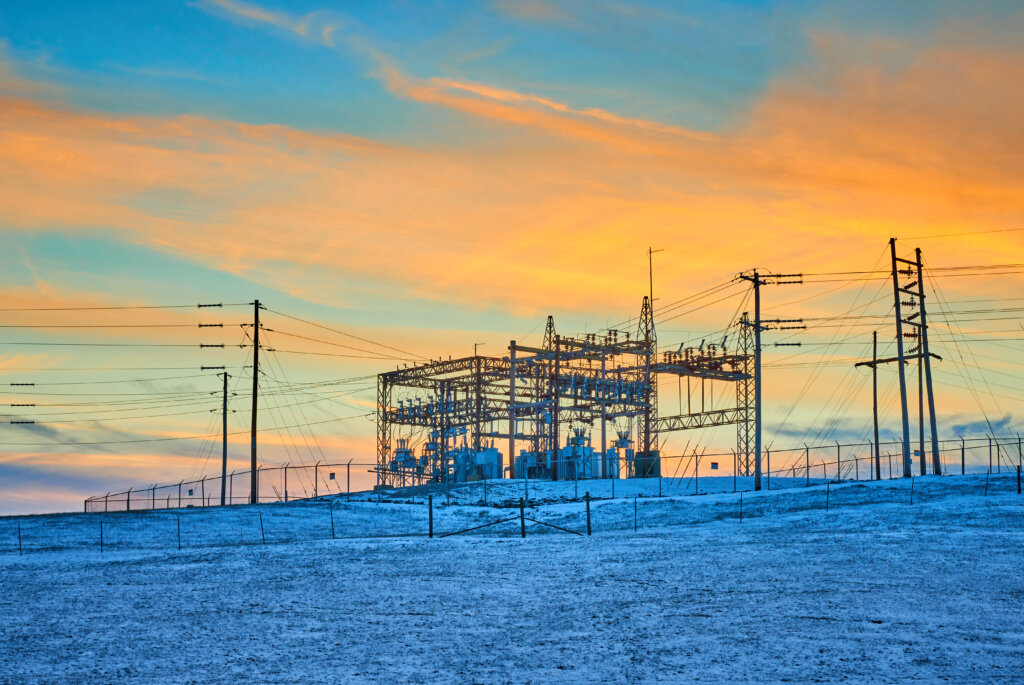
Typical electric utility substation.
The Heart Of Electrical Power: What Substations Do
An electric substation is a control center where electricity is transformed, managed, and routed on its way from generation sources to consumers. There are over 75,000 substations across the United States, serving more than 3,000 electric utility companies … each relying on these critical assets to deliver safe and stable power.
Far more than passive infrastructure, substations function as strategic grid control hubs. They are integral to managing load, rerouting power during outages, and supporting renewable energy integration and decentralization trends. Substations perform several core functions, and include several key components … including transformers, circuit breakers, switchgear, and battery energy storage systems (BESS). The illustration below highlights the key functions of substations throughout the electrical grid:
- Voltage Transformation for long-distance transmission and distribution throughout the grid
- Switching and Routing Operations to control the flow of electricity and enhance the overall grid reliability
- Monitoring and Control Systems to continuously observe parameters, detect anomalies, and provide precise grid optimization
- Energy Storage Integration that employs Battery Energy Storage Systems (BESS) to manage renewable energy variability and respond dynamically to grid fluctuations
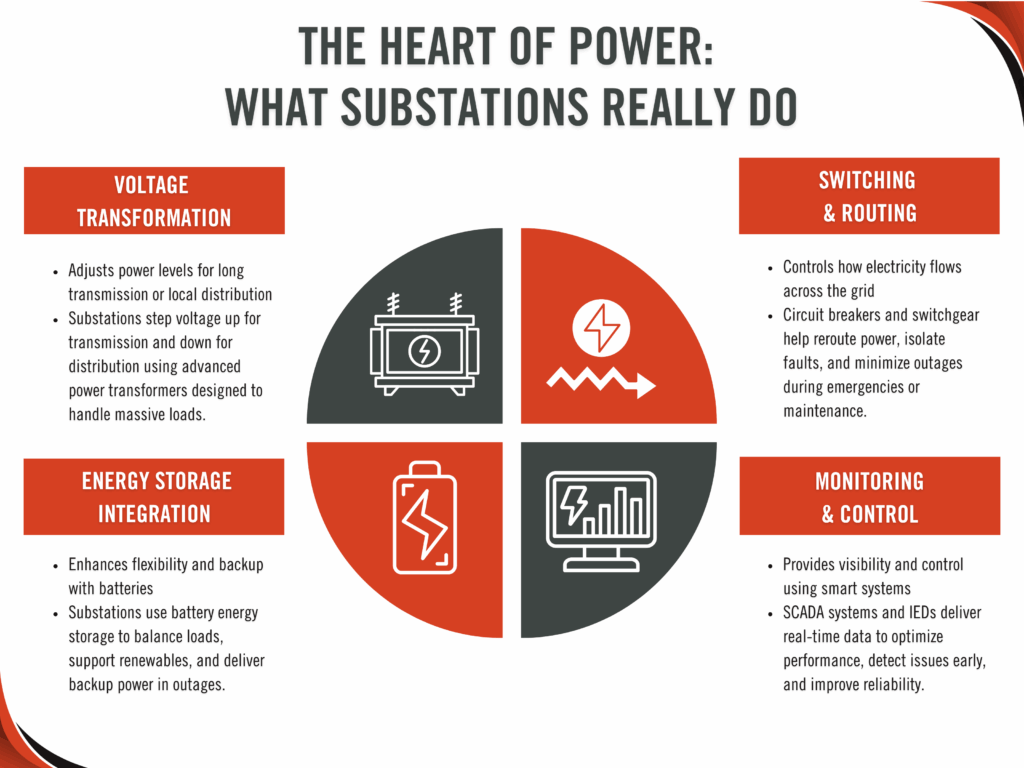
Under Pressure: Why Substations Are A Critical Risk Point
Substations are facing unprecedented strain as multiple, complex challenges converge to test their resilience and reliability. Not only are these facilities grappling with aging infrastructure and outdated technology, but they must also accommodate rapidly rising energy demands driven by electrification and economic growth. At the same time, substations are increasingly exposed to extreme weather events, sophisticated cyber and physical threats, and persistent supply chain disruptions that delay critical repairs and upgrades.
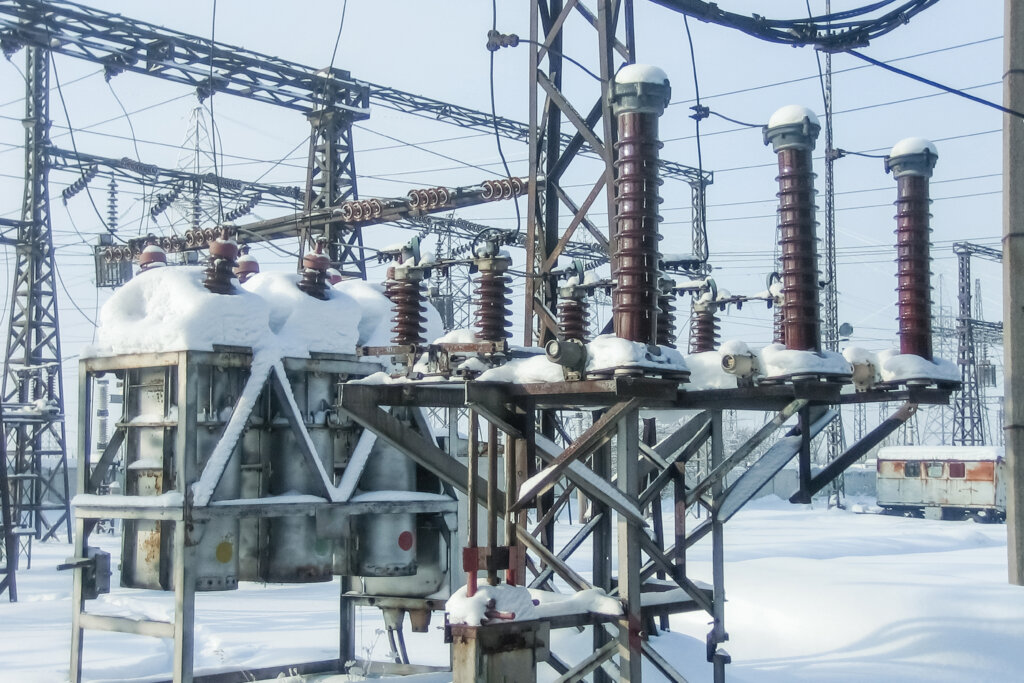
Aging substation infrastructure in heavy snow.
Aging Infrastructure
The average age of U.S. power transformers now exceeds 40 years, well beyond their intended design life of 25–30 years … which increases the risk of catastrophic failure due to insulation breakdown and mechanical fatigue. Many substations still rely on legacy equipment, such as oil-filled breakers and electromechanical relays, which lack the diagnostic and self-monitoring capabilities of modern digital systems. Budget constraints and deferred maintenance have resulted in a significant backlog of critical upgrades, leaving many substations operating with components that are increasingly susceptible to faults and unplanned outages.
Rising Energy Demand
The rapid electrification of transportation, heating, and industrial processes is driving unprecedented load growth and affecting power distribution … therefore pushing substations to operate closer to their maximum rated capacities. Many existing substations were designed for lower, more predictable loads and now face frequent overload conditions, which can accelerate equipment aging, increase the risk of thermal runaway, and compromise system reliability.
Supply Chain and Component Challenges
The procurement of large power transformers and other specialized components is hampered by global supply chain constraints, with lead times often stretching 12 – 24 months or longer, making rapid replacement after a failure impossible. Aging insulation materials and cumulative mechanical stresses increase the likelihood of sudden, unplanned failures, while the scarcity of spare parts and skilled labor further complicates timely repairs and system restoration.
Extreme Weather Events
The frequency and severity of hurricanes, wildfires, ice storms, and heatwaves are rising, exposing substations to physical threats such as flooding, fire damage, and thermal stress. Substations are particularly vulnerable to water ingress, which can short-circuit high-voltage equipment … and also to overheating, which can degrade insulation and cause failures in transformers. When substations are damaged by extreme weather, restoration efforts are often delayed due to the complexity of repairs and the need for specialized replacement parts, prolonging outages for entire communities.
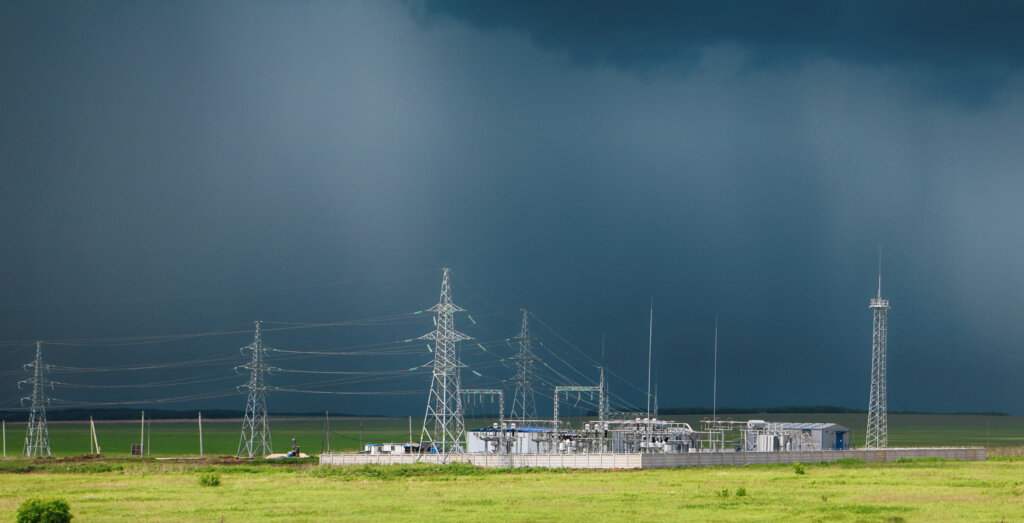
Rural substation facing imminent severe weather.
Cyber and Physical Threats
Substations have become high-value targets for both physical attacks, such as vandalism or gunfire; as well as sophisticated cyber intrusions that can disable protective relays or disrupt control systems. As substations serve as critical nodes in the grid, a successful attack on a single facility can propagate through the network, causing cascading outages that impact large geographic areas and critical infrastructure.
What’s At Stake
A single substation failure can trigger a chain reaction of problems that extend far beyond the immediate area it serves. Because substations function as critical nodes in the electrical grid — regulating voltage, managing transmission, routing power, facilitating power distribution, and protecting against faults — their failure can disrupt the flow of electricity to thousands or even millions of customers. This disruption can quickly cascade through interconnected systems, causing widespread outages, halting business operations, and jeopardizing essential services such as hospitals, emergency response, data centers, and transportation networks. The consequences are not only technical … but also economic and reputational, as utilities face lost revenue, regulatory scrutiny, and a loss of public trust. In essence, the failure of a single substation can compromise the stability and reliability of the entire grid, underscoring the importance of proactive maintenance and modernization.
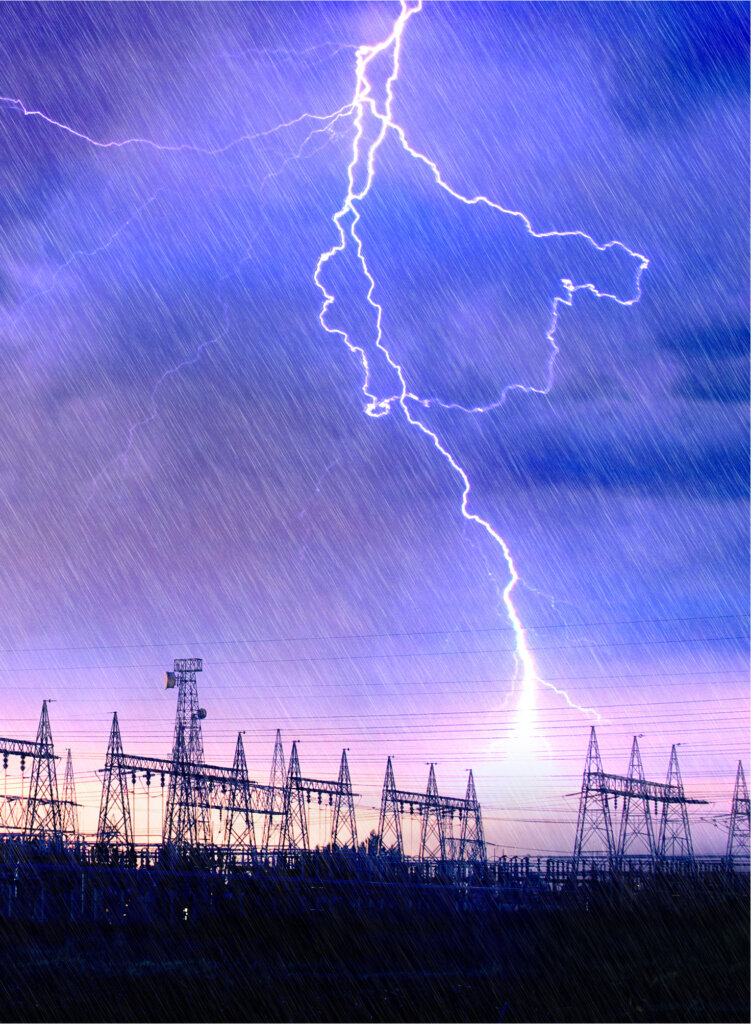
Direct lightning strike to a substation’s high voltage towers.
- Widespread outages impacting several thousand to several million people. A substation failure can disrupt electricity flow across large portions of the grid, triggering cascading outages and distribution failures that disconnect multiple feeders and other substations … thus affecting vast areas and populations.
- Lost revenue for utilities and businesses. Substation failures halt operations and production, causing significant financial losses for both utilities and their commercial customers, and may also result in regulatory penalties for prolonged outages.
- Disruption of critical services, including hospitals, data centers, transportation, and emergency response. Substation failures can compromise essential infrastructure and public safety, as backup power is often insufficient for prolonged outages or sensitive operations.
- Reputational damage and regulatory consequences. Major outages can erode public trust and lead to regulatory scrutiny, fines, and costly mandated improvements for utilities.
The cost of unplanned grid failure can reach millions of dollars per hour for industrial customers … while broader regional blackouts cost the economy billions of dollars per occurrence. The difference between a planned upgrade and an emergency restoration is measured in time, cost, and public trust.
Resilience Through Readiness: Applying The 4 R’s
The pressure facing substations highlights the critical importance of the 4 R’s of utility resilience: Readiness, Response, Recovery, and Restoration — a continuous cycle that determines how effectively utilities can withstand and overcome disruptions. Our June 12 post “Ahead Of The Storm: An Innovative Approach To Utility Resilience” explores how these “4 R’s” guide today’s utilities (including their substations) through increasingly severe and frequent weather events. Each phase reinforces the other phases … lessons learned become tools for the future. Additionally, this article illustrates why “customer trust”, operational agility, and long-term resilience hinge on embracing the full spectrum of natural disaster readiness and response.
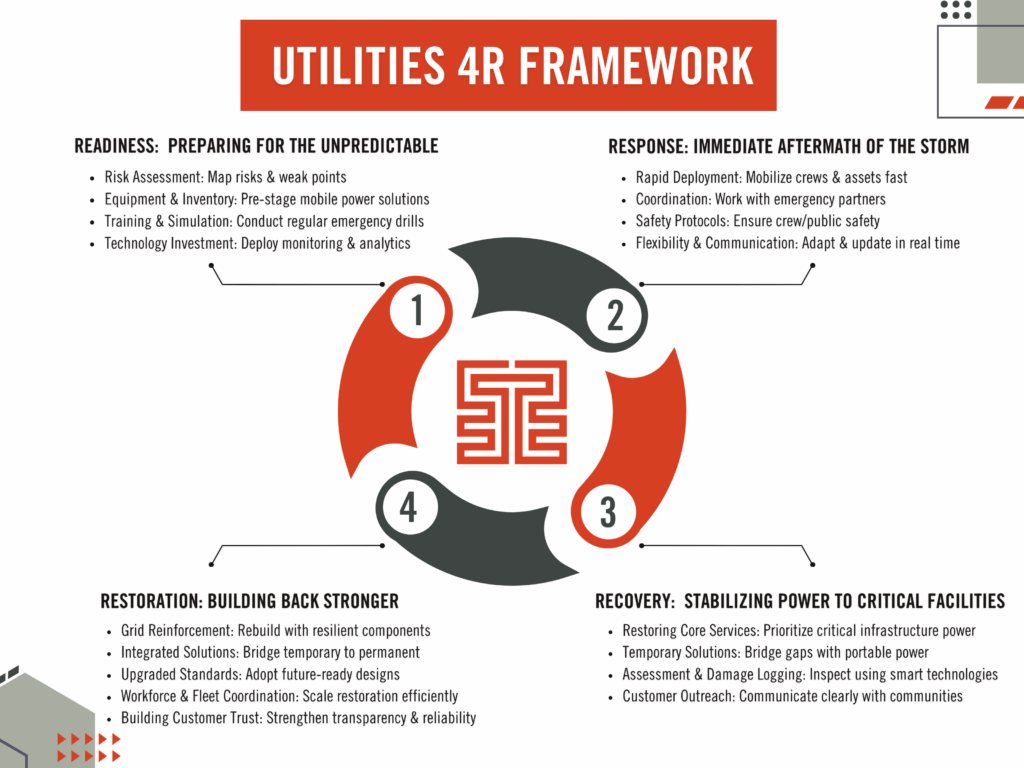
Investing in substation readiness — through planned maintenance, digital modernization, and readiness drills — not only reduces outage durations and costs, but also transforms resilience from a reactive necessity into a strategic advantage. As emphasized in Trystar’s approach, the utilities that thrive in an era of escalating threats are those that prepare the smartest, not just those that restore the fastest. Readiness is a risk mitigation strategy that safeguards the entire grid and the communities it serves.
Conclusion
Electrical substations serve as the critical backbone of the power grid, orchestrating voltage regulation, power routing, transmission, distribution, and real-time control to ensure reliable electricity delivery. However, these vital nodes are increasingly strained by aging infrastructure, surging energy demands, extreme weather events, as well as evolving cyber and physical threats. The convergence of these challenges exposes substations to heightened risks of failure, with the potential for cascading outages, economic losses, and disruptions to essential services. As substations age beyond their intended lifespan and face deferred maintenance, utilities must contend with long lead times for replacement components and the growing complexity of grid management in a rapidly electrifying world.
To meet these challenges, utilities must embrace a holistic approach grounded in the 4 R’s of resilience: Readiness, Response, Recovery, and Restoration. Proactive investments in risk assessment, digital modernization, and strategic equipment staging are essential for anticipating threats and minimizing outage impacts. Rapid response and recovery efforts, supported by advanced technologies and clear communication, ensure critical services remain operational during crises. Restoration efforts that prioritize infrastructure upgrades and smart grid integration will reinforce long-term reliability and public trust. Now is the time for utilities, policymakers, and industry leaders to prioritize substation modernization and resilience planning — because the future of the grid and the communities it serves, depends on it.
Contact us to start the conversation about substation and grid resiliency solutions to ensure that you are prepared for the challenges ahead!